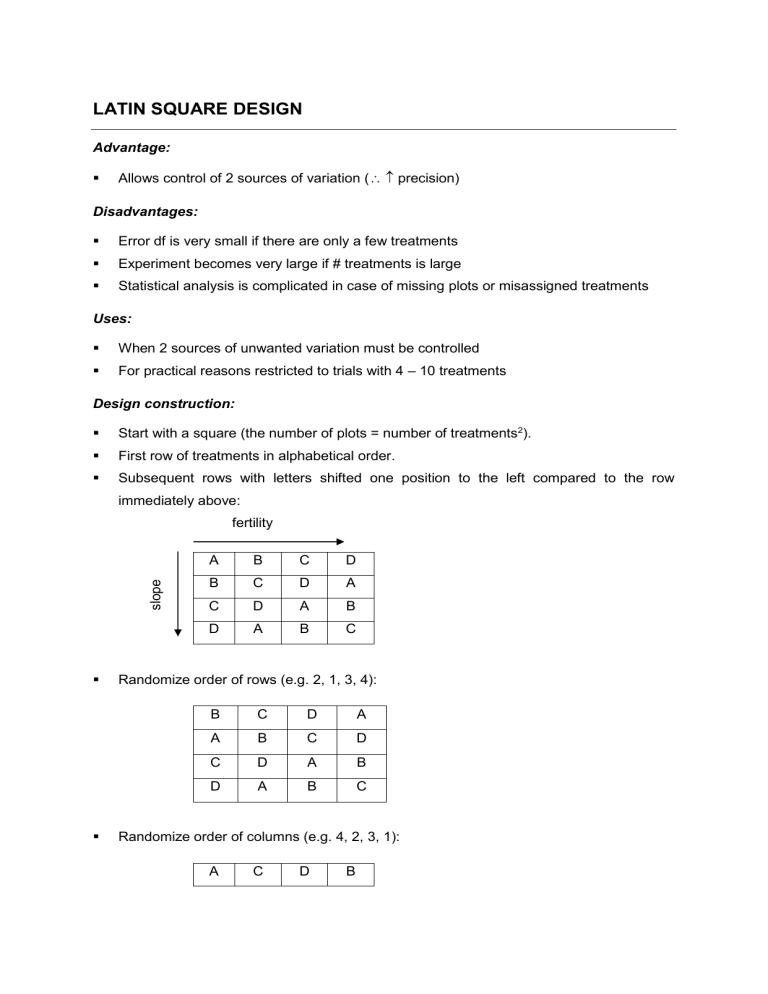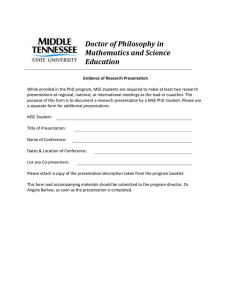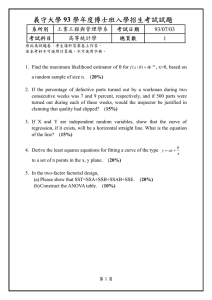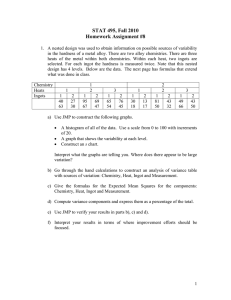
LATIN SQUARE DESIGN Advantage: Allows control of 2 sources of variation ( precision) Disadvantages: Error df is very small if there are only a few treatments Experiment becomes very large if # treatments is large Statistical analysis is complicated in case of missing plots or misassigned treatments Uses: When 2 sources of unwanted variation must be controlled For practical reasons restricted to trials with 4 – 10 treatments Design construction: Start with a square (the number of plots = number of treatments2). First row of treatments in alphabetical order. Subsequent rows with letters shifted one position to the left compared to the row immediately above: slope fertility A B C D B C D A C D A B D A B C Randomize order of rows (e.g. 2, 1, 3, 4): B C D A A B C D C D A B D A B C Randomize order of columns (e.g. 4, 2, 3, 1): A C D B D B C A B D A C C A B D Analysis: The procedure of analysis is similar to the randomized and randomized block designs. Row x column table of observations and totals for Latin square design Column Row 1 2 3 4 Sum 1 y11 y12 y13 y14 R1 2 y21 y22 y23 y24 R2 3 y31 y32 y33 y34 R3 4 y41 y42 y43 y44 R4 Sum C1 C2 C3 C4 G Treatment totals and means for Latin square design Treatments Rep. 1 2 3 4 1 y11 y12 y13 y14 2 y21 y22 y23 y24 3 y31 y32 y33 y34 4 y41 y42 y43 y44 Sum Sum T1 T2 T3 T4 G Mean y1 y2 y3 y4 y ANOVA-table for Latin square design (n = p2) Source df SS MS F Treatment p–1 SST MST FT Row p–1 SSR MSR FR Column p–1 SSC MSC FC Error (p – 1)(p – 2) SSE MSE Total n–1 SSTot CF = G2/n (correction factor) MST = SST/dfT FT = MST/MSE SSTot = [ all (observations)2] – CF MSR = SSR/dfR FR = MSR/MSE SST = [1/r x all(T2)] – CF MSC = SSC/dfC FC = MSC/MSE SSR = [1/p x all(R2)] – CF MSE = SSE/dfE SSC = [1/p x all(C2)] – CF SSE = SSTot – SST – SSR – SSC FACTORIAL EXPERIMENTS Interactions The traditional approach is to look at only one factor in an experiment. But a researcher can also evaluate the influence of more factors in a single experiment, e.g. cultivar (C) and nitrogen level (N): C1 C1 C2 C2 Yield Yield C3 C3 A 0 20 40 60 80 B 0 20 40 60 80 Nitrogen level (kg/ha) Main effects: Factors act independently of each other, e.g. every cultivar reacts in the same way towards the increasing N-level (A). Interaction: The effects of two or more factors are not independent from each other, e.g. different cultivars react differently towards increasing N fertilization (B). Factorial experiments Interactions are very common. If an experiment is planned to enable measurement and testing of interactions between different factors, we call it a factorial experiment. Note, this is not an experimental design, it only describes the nature of the treatments! Advantages: Saves time and materials for two reasons: - Main effects are all that are required to describe the results. - Hidden replication. Disadvantages: As the number of factors increases, there is a great increase in the number of treatments. Large factorials are difficult to interpret, especially if interactions are present. Uses: Exploratory experiments – to determine which factors are important. To study relationships among a number of factors. Trails designed to make recommendations over a wide range of conditions (conditions included as factors) Layout: Choose an experimental design appropriate for the site of the trial. The treatments will look a bit different, as there will be more than one factor. Analysis: Follows the same pattern as the single factor experiments already discussed. Two-factor experiments Say an experiment is performed with two factors, A and B. A at 3 levels and B at 2 levels and a randomized block design with 4 blocks is used: Number of plots = A x B x blocks = 3 x 2 x 4 = 24 plots Treatments = 3 x 2 = 6 different treatment combinations A1B1 A1B2 A2B1 A2B2 A3B1 A3B2 Design construction: I II III IV A2B1 A3B2 A2B2 A1B1 A3B1 A1B1 A1B2 A3B1 A1B1 A3B1 A1B2 A3B2 A2B1 A1B2 A3B2 A2B2 A1B2 A2B2 A3B1 A2B1 A3B2 A2B2 A1B1 A2B1 Analysis: Table of treatment observations, means and totals for a two-factor experiment (RBD) Factors A1 A2 A3 Block B1 B2 B1 B2 B1 B2 Sum 1 y11 y12 y13 y14 y15 y16 R1 2 y21 y22 y23 y24 y25 y26 R2 3 y31 y32 y33 y34 y35 y36 R3 4 y41 y42 y43 y44 y45 y46 R4 Sum T11 T12 T21 T22 T31 T32 G Mean y11 y12 y21 y 22 y31 y32 y Two-way table of factor A and B totals Factor B Factor A 1 2 Sum 1 T11 T12 A1 2 T21 T22 A2 3 T31 T32 A3 Sum B1 B2 G ANOVA for a 2-factor factorial experiment (RBD) Source df SS MS F A a–1 SSA MSA FA B b–1 SSB MSB FB AB (a – 1)(b – 1) SSAB MSAB FAB Block r–1 SSR MSR FR Error (r – 1)(ab – 1) SSE MSE Total rab - 1 SSTot CF = G2/n (Correction Factor) MSX = SSX/dfX SSTot = [ all (observations)2] – CF FA = MSA/MSE SSA = [1/rb x all(A2)] – CF FB = MSB/MSE SSB = [1/ra x all(B2)] – CF FAB = MSAB/MSE SSAB = [1/r x all(T2)] – CF – SSA – SSB FR = MSR/MSE SSR = [1/p x all(R2)] – CF SSE = SSTot – SSA – SSB – SSAB – SSR Important: As a general rule we do not look at the main effecs if the interaction is significant, in other words, you should only report on the interaction. Only if the interaction is not significant one should consider the significance of main effects. THREE-FACTOR EXPERIMENTS The same procedures are followed as for two-factor experiments, but more complicated interactions are involved. Effects that should be considered: 3 main effects (A; B; C) 3 first order interactions (AxB; AxC; BxC) 1 second order interaction (AxBxC) Block (randomized block design) / row and column (Latin square design) Example: Say factor A (2 levels), factor B (2 levels), and factor C (3 levels) are investigated. The experiment is planned according to the completely randomized design with 3 replications. Number of plots = 2 x 2 x 3 x 3 = 36 plots Treatments = 2 x 2 x 3 = 12 combinations A1B1C1 A1B2C1 A2B1C1 A2B2C1 A1B1C2 A1B2C2 A2B1C2 A2B2C2 A1B1C3 A1B2C3 A2B1C3 A2B2C3 Design construction: (Completely randomised design) A1B1C3 A2B1C3 A2B1C2 A1B1C1 A2B1C1 A1B1C2 A1B2C3 A2B2C2 A1B1C2 A2B1C3 A1B2C2 A2B2C3 A2B1C1 A1B1C1 A1B2C1 A1B1C3 A2B2C2 A2B2C1 A2B2C1 A2B1C2 A2B2C3 A1B2C3 A2B1C2 A1B2C2 A1B2C1 A2B2C1 A1B2C2 A2B1C1 A1B1C1 A2B1C3 A2B2C3 A1B1C3 A2B2C2 A1B1C2 A1B2C3 A1B2C1 Table of observations, totals and means for treatments (CRD) A1 A2 B1 B2 B1 B2 C2 C3 C1 C2 C3 C1 C2 C3 C1 C2 C3 y1111 y1112 y1113 y1121 y1122 y1123 y1211 y1212 y1213 y1221 y1222 y1223 y2111 y2112 y2113 y2121 y2122 y2123 y2211 y2212 y2213 y2221 y2222 y2223 y3111 y3112 y3113 y3121 y3122 y3123 y3211 y3212 y3213 y3221 y3222 y3223 T111 T112 T113 T121 T122 T123 T211 T212 T213 T221 T222 T223 G y111 y112 y113 y121 y122 y123 y 211 y212 y213 y 221 y222 y223 y Sum C1 Three-way table of factor totals C A B 1 2 3 Sum 1 1 T111 T112 T113 T11. 2 T121 T122 T123 T12. Sum T1.1 T1.2 T1.3 A1 1 T211 T212 T213 T21. 2 T221 T222 T223 T22. Sum T2.1 T2.2 T2.3 A2 C1 C2 C3 G 2 Sum Two-way table of AC totals Two-way table of AB totals Factor C Factor B Factor A 1 2 Sum Factor A 1 2 3 Sum 1 T11. T12. A1 1 T1.1 T1.2 T1.3 A1 2 T21. T22. A2 2 T2.1 T2.2 T2.3 A2 Sum B1 B2 G Sum C1 C2 C3 G Two-way table of BC totals Factor C Factor B 1 2 3 Sum 1 T.11 T.12 T.13 B1 2 T.21 T.22 T.23 B2 Sum C1 C2 C3 G ANOVA for 3-factor factorial experiment (CRD) Source df SS MS F A a–1 SSA MSA FA B b–1 SSB MSB FB C c–1 SSC MSC FC AB (a – 1)(b – 1) SSAB MSAB FAB AC (a – 1)(c – 1) SSAC MSAC FAC BC (b – 1)(c – 1) SSBC MSBC FBC ABC (a – 1)(b – 1)(c – 1) SSABC MSABC FABC Error (r – 1)(abc – 1) SSE MSE Total rabc – 1 SSTot CF = G2/n (correction factor) MSX = SSX/dfX SSTot = [ all (observations)2] – CF Fx = MSX/MSE SSA = [1/rbc x all(A2)] – CF SSB = [1/rac x all(B2)] – CF SSC = [1/rab x all(C2)] – CF SSAB = [1/rc x all(AB2)]–CF–SSA–SSB SSAC = [1/rb x all(AC2)]–CF–SSA–SSC SSBC = [1/ra x all(BC2)]–CF–SSB–SSC SSABC = [1/r x all(T2)]–CF–SSA–SSB–SSC–SSAB–SSAC–SSBC SSE = SSTot–SSA–SSB–SSC–SSAB–SSAC–SSBC–SSABC C: LSD 0.05 MSE rab q0.05 (# C levels / dfE) Important: If 2nd order interaction is significant, do not look at the rest. If 2nd order interaction is not significant, look at 1st order interactions. Look only at main effects when there is no significant interaction with that factor!




